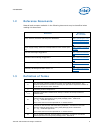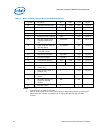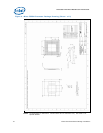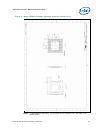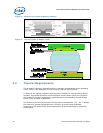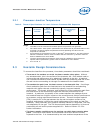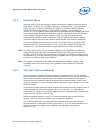
Processor Thermal/Mechanical Information
16 Thermal and Mechanical Design Guidelines
2.1.2 Heatsink Attach
2.1.2.1 General Guidelines
The micro-FCBGA package may have capacitors placed in the area surrounding the
processor die. The die-side capacitors, which are only slightly shorter than the die
height, are electrically conductive and contact with electrically conductive materials
should be avoided. The use of an insulating material between the capacitors and any
thermal and mechanical solution should be considered to prevent capacitors shorting.
A thermal and mechanical solution design must not intrude into the required keep-out
zones as specified in the datasheet.
There are no features on the 479-pins micro-FCBGA package for direct heatsink
attachment: a mechanism must be designed to attach the heatsink directly to the
motherboard. In addition to holding the heatsink in place on top of the processor die,
this mechanism plays a significant role in the robustness of the system in which it is
implemented, in particular:
• Ensuring thermal performance of the thermal interface material (TIM) applied
between the processor die and the heatsink. TIMs based on phase change
materials are very sensitive to applied pressure: the higher the pressure, the
better the initial performance. Designs should incorporate a possible decrease in
applied pressure over time due to potential structural relaxation in retention
components (creep effect causing clip to lose its preload and causing anchor pull-
out). It is not recommended to use TIMs such as thermal greases onto small bare
die package, due to the TIM “pump-out” concern after heatsink is assembled.
• Ensuring system electrical, thermal, and structural integrity under shock and
vibration events. The mechanical requirements of the heatsink attach mechanism
depend on the mass of the heatsink and the level of shock and vibration that the
system must support. The overall structural design of the motherboard and the
system should be considered in designing the heatsink attach mechanism. The
design should provide a means for protecting the solder joints.
2.1.2.2 Heatsink Clip Load Requirement
The attach mechanism for the heatsink developed to support the processor creates a
nominal static compressive preload on the package of 9.9 lbf ± 1.2 lbf throughout the
life of the product for designs compliant with the Intel reference design assumptions:
• Using TIM Honeywell PCM45F (pad version).
• 55.88 mm (2.2”) x 54.88 mm (2.16”) attach pattern. Refer to
Figure 21 for
heatsink keep-out zone.
• And no board stiffening device (backing plate, chassis attach, etc.).
The minimum load is required to thermal performance while protecting solder joint
against fatigue failure in temperature cycling.
Notes the load range above is required to ensure a minimum load of 8.7lbf at end-of-
life. The tolerance and nominal load is based on reference design and will slightly
differ on alternate thermal solution provided by third party.
It is important to take into account potential load degradation from creep over time
when designing the clip or fastener to the required minimum load. This means that,




